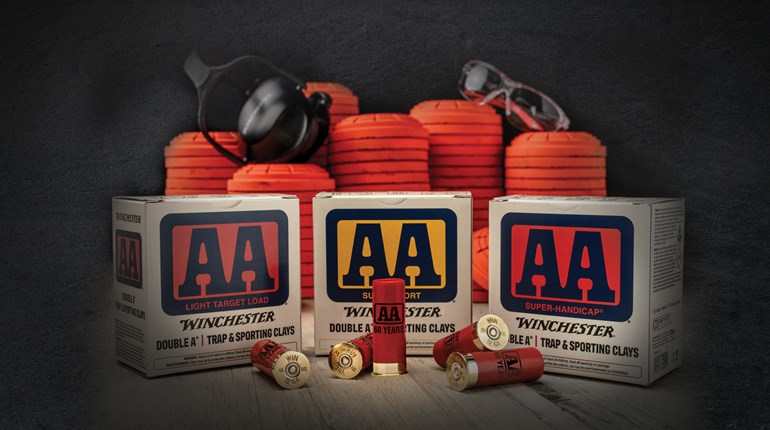
Sporting clays has been likened to playing golf with a shotgun, not only because the courses have various shooting stations like a golf course has holes, but because of the social aspect of the sport, as well. Two, three or four shooters usually make up a sporting clays squad, where hits are celebrated while misses may draw some good-natured ribbing. If you’d like to make those misses a little less frequent, some solo practice on the range can bring big benefits.
First, a note: Most sporting clays ranges today are equipped to let you practice by yourself with electronic target throwers. Simply set the thrower controller box to “solo” and a three-second delay allows you to press the target-release button, then mount your shotgun before a target(s) is launched. The arrangement is ideal for practicing those shots you struggle with, and the great part is that no one is there watching, adding extra pressure.
A longtime NRA member, Dan Bailey is the owner of Eagle’s Nest Sporting Grounds, a relatively new sporting clays, 5-Stand and FITASC range in north-central Ohio. An accomplished clays shooter and Professional Sporting Clays Association pro, Bailey has a few tips for getting the most out of your solo practice time.
1. Learn to Read the Target
“The main thing is learning how to ‘read’ the flight of a target, then having your eyes focus on the target in the right place,” said Bailey. “Learn those two things and you’ll begin breaking more clays more consistently. When most shooters come to me for coaching, they’ve usually not spent enough time watching targets. They want to shoot first then analyze why they missed—and that’s a mistake.”
After you’ve watched a particular target and determined where along its flight path you plan to break it, work your way back from there to a hold point. In other words, where will you hold the muzzle of your shotgun before calling for a target? Bailey said that every shooter and every shot is a little different, but in general your hold point should be where the target first becomes clear to your eye. For example, when a target is thrown your eyes first see it as a blur; then, the target suddenly reaches a point in flight when you see it as sharply focused. That’s the place where you should hold the muzzle of your shotgun: the point where the target becomes clear.
“Once the target becomes clear, focus your eyes on its leading edge,” said Bailey. “If you imagine the target as having a clock face superimposed over it, in a left-to-right crossing target your eyes should be focused at the 3:00 o’clock position. If it is a right-to-left target, your eyes should be at the 9:00 o’clock position. In other words, look at where the target is going. If you simply focus on the whole target you’ll likely shoot behind it because your eyes are looking where the target has been, not where it’s going.”
2. Learn When to Slap the Trigger
So when should you pull the trigger? “Once you’ve determined a hold point and called for the target, stay in front of it, match the speed of the target with your gun swing, and pull the trigger,” said Bailey. “It’s really that simple. Not easy, but simple.”
The goal of solo practice should be to build consistency by doing the same things over and over again correctly: stance, hold point, gun mount, matching the speed of the target with your gun swing, follow through, etc. The more you practice those skills, the more they begin to feel second nature. The idea is to develop muscle memory by establishing a shooting routine.
You’ll know you’re making progress when those things you had to think about as a new sporting clays shooter eventually become easier. You won’t have to consciously concentrate on them anymore; your body just performs the skills automatically.
3. Walk Before You Run
Bailey also suggested not shooting a sporting clays course during practice as you would when shooting a round with your buddies. “Don’t feel as if you have to shoot each station, and don’t necessarily shoot doubles. Maybe shoot five single targets per station. Then, as you start feeling more confident, shoot a pair or two of doubles. Mix it up. Build your confidence with easier shots, then work on those shots that are more difficult for you.”
And he strongly recommends—before going solo—hiring a shooting coach. “It’s difficult to teach yourself how to play the sporting clays game,” he said. “To do it, you’ll shoot 10 times the number of shells on your own without an instructor as you could by shooting one-tenth the number of shells with a good instructor.”
Hiring a shooting coach may seem expensive; for instance, Bailey charges $100 per hour. But according to him, in an hour or two with a coach you will have learned more than a shooter who spends $2,000 in shotgun shells trying to learn on their own.
A good way to learn the basics at home that costs you nothing is practicing your stance and gun mount. With an unloaded shotgun (duh!), bring the gun to your shoulder about a dozen times in succession; then, set it down and let your arms rest for a minute or two before doing it again. Repeating several repetitions of this exercise several times per week, if not daily, will assure that your shotgun always comes to the same place on your shoulder each time it’s mounted. And that’s one of the keys to good shotgun shooting technique.
4. Trust Yourself
Lastly, Bailey said to trust your body’s natural instincts. “Your eyes and hands will naturally go to the correct lead a target requires if you will let them,” he said. “If your eyes are looking in the right place, your hands will naturally follow. It may not seem comfortable at first, but when you break a target and understand how much lead it took to do so, your brain will learn from that experience and you’ll begin breaking more and more targets more consistently. In essence, sporting clays is all about placing the shot where the target is going, not where it’s been.”
Easier said than done, but that’s the challenge and fun of sporting clays…pull!







































